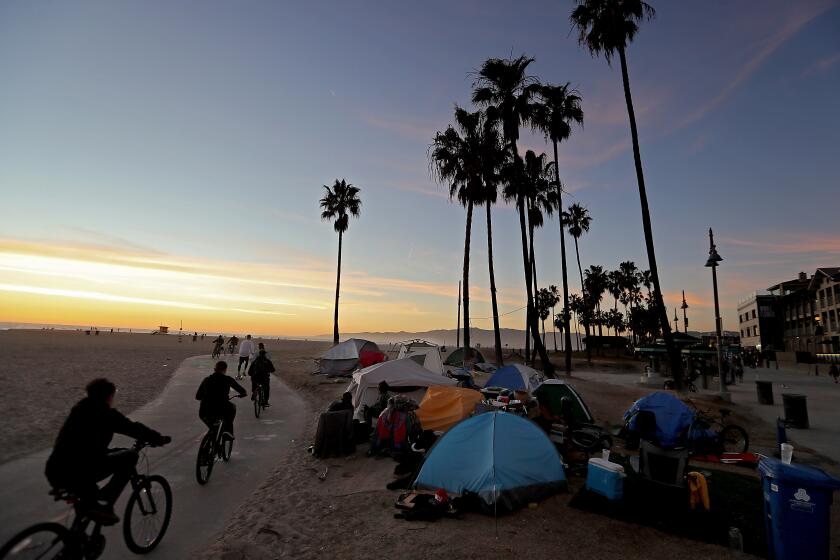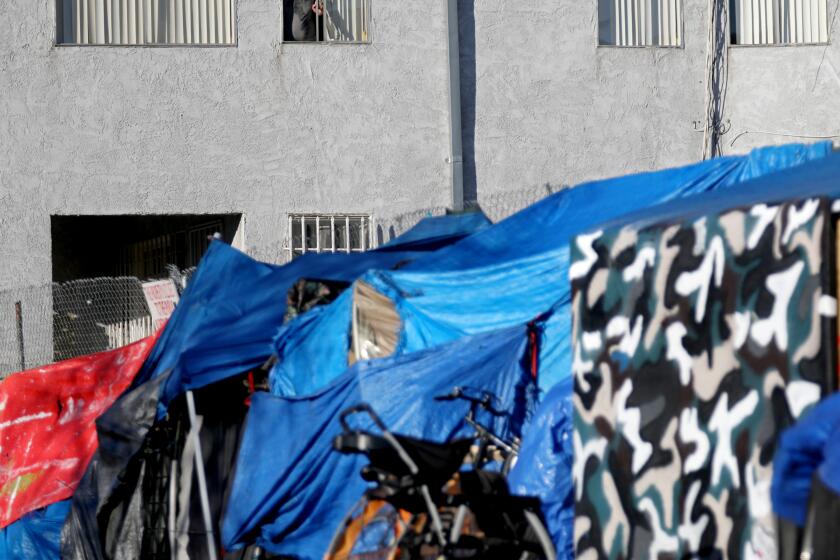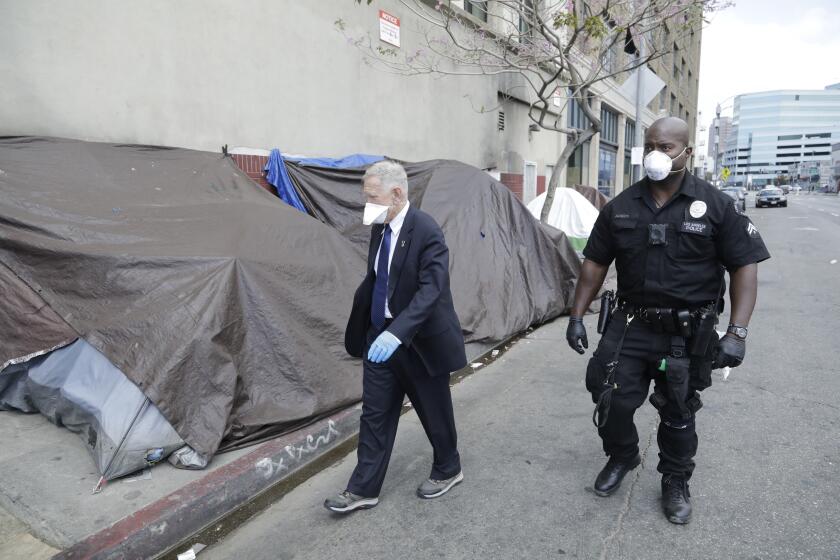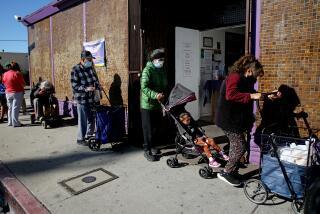Despite appearances, 12% fewer homeless people were on Hollywood streets this year
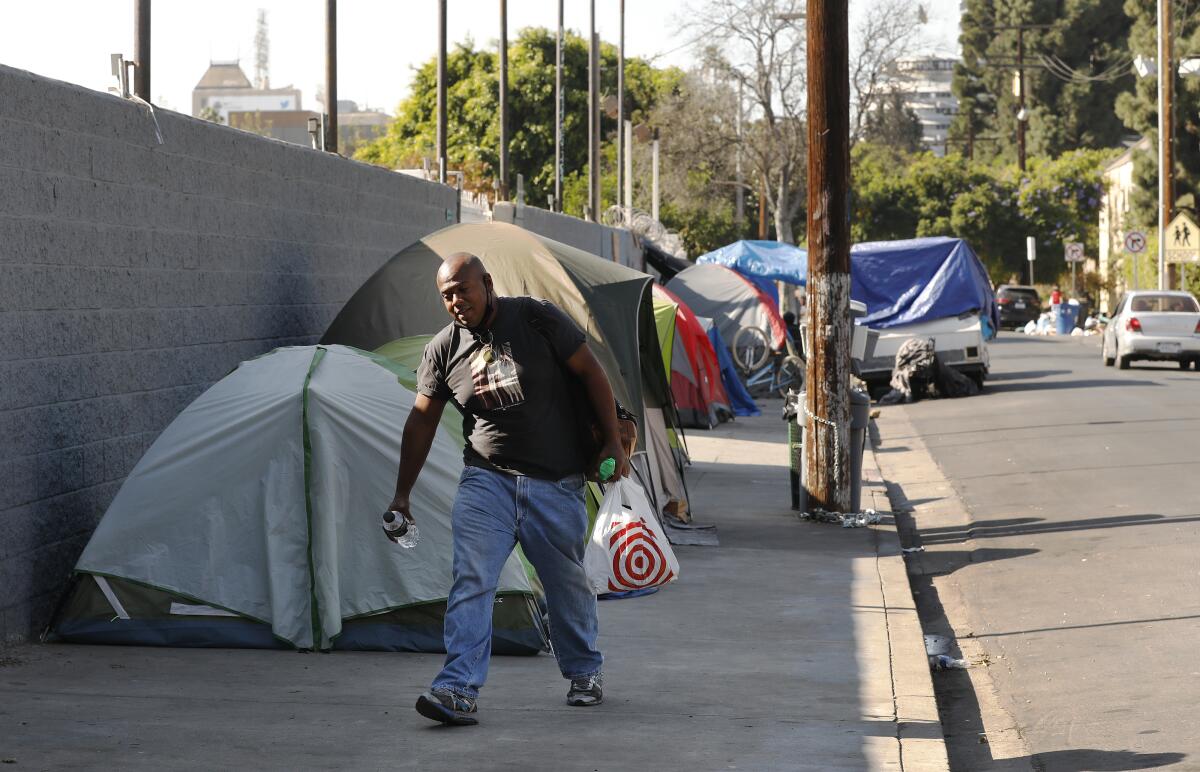
- Share via
At a time when multiplying tent camps are making homelessness appear to be an ever-worsening fact of life in Los Angeles, a sign of hope has arisen in Hollywood, historically among the region’s magnets for those living on the fringe.
Last year, contrary to what many residents and homeless advocates alike perceived, the number of people sleeping on Hollywood’s streets declined by 12%, reversing an upward trend of several years.
That’s the finding of an unofficial count of the unsheltered population conducted by a coalition of Hollywood businesses, churches and nonprofit groups that stepped up to fill the void when this year’s countywide count was canceled due to the coronavirus.
The survey, released Tuesday, found homelessness down 12% on average in the 40 census tracts that make up Hollywood and East Hollywood. But the change was markedly uneven across that area, a phenomenon that helped explain how the total could be down even as some homeless camps were growing larger.
The COVID-19 pandemic has exacerbated the issue of homelessness in Southern California. We share images reminiscent of the Great Depression.
Large percentage increases in the number of people living in tents and vehicles were recorded in three East Hollywood census tracts between Vermont and Normandie avenues, more than quadrupling the homeless population there to nearly 100. Meanwhile, other areas had decreasing numbers of people living in tents and cars. Overall, the number of people in tents and cars declined slightly.
Most of the difference was attributed to the reduction in people living completely exposed — lying on sidewalks and sleeping in doorways — who make up about a quarter of the population. That group was down 30% — from 578 last year to 401 this year.
The overall total this year was estimated at 1,513, down from 1,714 last year.
The count was organized by Hollywood 4WRD (an acronym for walls, roofs and doors), a coalition that formed as a volunteer group in 2008 and recently incorporated as a nonprofit. Groups it marshaled for the count included the Central Hollywood Neighborhood Council, My Friend’s Place, Hang Out Do Good, the Center in Hollywood, and the Saban Community Clinic.
Organizers did not have access to confidential data maintained by the Los Angeles Homeless Services Authority that might illuminate why the numbers were down. They speculated that Project Roomkey, the FEMA-funded program that housed thousands of vulnerable homeless people in hotels last year, plus the opening of a new city Bridge Home shelter on Riverside Drive and 120 new units of permanent supportive housing were major factors.
“The takeaway is that some stuff seems to have worked,” said Louis Abramson, a member of the Central Hollywood Neighborhood Council and an astrophysicist with the Carnegie Observatories, who oversaw the survey.
“This survey shows that interventions can help those struggling with housing insecurity,” said Steve Fiechter, board member of Hollywood 4WRD and senior director at PATH. “I’m thrilled that the community has come together this way and there is a broad coalition that came together to create solutions to bring our homeless neighbors home and improve our communities.”
A new City Council member for the area has said L.A. city officials are asleep at the wheel. Now she’s seeing how complex the situation is.
The decline in those living without any shelter was not entirely a surprise, even though “the optics of tents that have not been removed and camps that have grown larger gives the impression that the situation has grown worse,” said Kerry Morrison, a founding member of Hollywood 4WRD, who counted people in the census tract around Hollywood Boulevard and Highland Avenue.
“I just remember not noticing as many people just huddled on the street or huddled in a doorway, which is something you would have seen in the past,” Morrison said.
“I found it to be good news. So much effort has been put into Project Roomkey and standing up temporary shelters and people being housed. We need to have some good news to keep everybody motivated to keep people moving forward.”
The survey was modeled after the methodology developed by the LAHSA with partners at the USC Schaeffer Center for the annual countywide count, Abramson said.
About 75 volunteers, mostly regulars from the LAHSA count, scoured the 40 census tracts on Feb. 25. Abramson said there were enough volunteers to count every census tract twice or more, allowing him to calculate the counting error, which he estimated at about 5%.
Noting that he, too, was surprised by the decline, he consulted with the USC statisticians, checked his analysis for missteps and personally recounted two census tracts.
Council members are discussing a settlement in a federal lawsuit that would entail thousands of new shelter beds and enforcement of anti-camping laws.
“Based on internal and external checks,” he said, I can’t break the results.”
Abramson said he was proud of what activists had accomplished in coming together to conduct the count, but he doesn’t consider it a model.
“I hope,” he said, “that we return to being committed as an entire government to making sure these critical data are being supplied to residents, the providers who need to know how many people need to be serviced and to legislators who need to be aware of these ground truths.”
More to Read
Sign up for Essential California
The most important California stories and recommendations in your inbox every morning.
You may occasionally receive promotional content from the Los Angeles Times.
